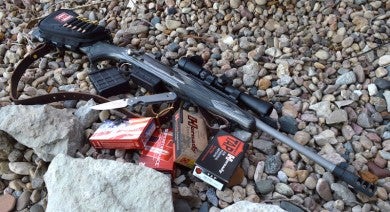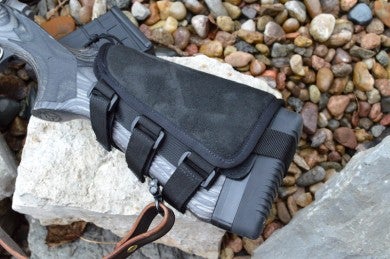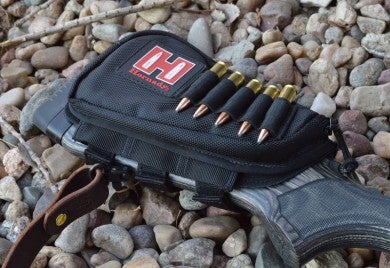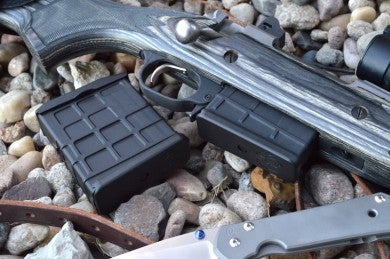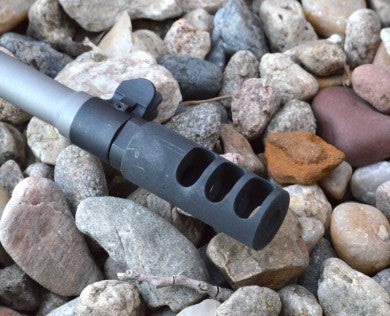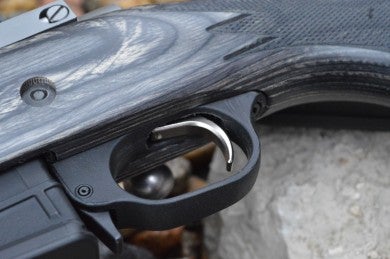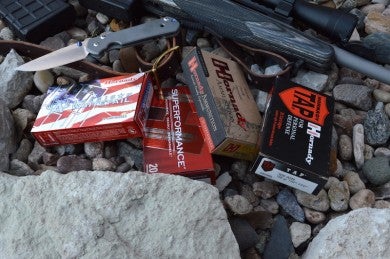Ruger .308 Gunsite Scout Rifle Re-do
Major Pandemic 03.28.15

The Ruger Gunsite Scout Rifle was specifically designed around Jeff Cooper’s concept of a Scout Rifle by some of his closest friends at Gunsite and Ruger. The Ruger Gunsite features bulletproof reliability, good usable accuracy, and provides for various magazine capacities. The rifle does all this while delivering the common sense scout rifle design elements that make it handy and user friendly. If you were only going to own one bolt action rifle, the Ruger Gunsite Scout should be it.
This collaboration produced a great version of the Cooper Scout rifle, which matches up well to his original guidelines. My version lacked a few tweaks after the initial review period to make it fit the scouting purpose. It needed a great sling, a sensible optic to extend the range of the gun, a better muzzle brake, improved shooter comfort, better trigger, and smaller polymer magazines with full capacity. For the extras, I fired up the world wide interweb and headed over to Brownells.com–because, ya know, they have everything.
Carryover Upgrades
In my original review of the Ruger Gunsite Scout rifle, it featured a Hi-Lux 2-7 scope and Andy’s Leather Rhodesian Scout sling.
An Andy’s Leather Rhodesian Scout Sling was carried over in the re-do. I personally consider it one of the finest leather slings you can put on a rifle. Think of it as the offspring of a National match and easily useable field sling. Technically it is the closest sling you will get to a Cooper recommended Ching Sling without adding extra swivel studs and a triple sling mount. It is a beautiful sling and has delivered everything I could possibly ask for from a sling supported shooting position. It does take a little practice to figure it out, but once you are locked in, you see the advantages downrange and want this on every rifle you own.
Ruger provided a forward mounted Picatinny rail for mounting the long-eye-relief optics as Cooper suggested. I topped the original build with a Hi-Lux/Leatherwood’s LER (Long-Eye Relief) variable power 2-7 Scout Rifle scope exactly where Cooper intended: way out in front of the bolt. Of note, the Hi-Lux Scout Rifle scope was designed specifically for the Ruger Gunsite rifle and delivers a .308 tuned BDC reticle, which aligns to a 200-yard zero with 300, 400, 500, and 600 yard aiming points and a breadth of magnification from 2-7x for very close and longer range targets. I have really grown to love the very often underestimated Hi-Lux optics performance. Hi-Lux’s clarity is excellent and, as equipped, matches almost perfectly to Cooper’s specs. Most importantly, the Leatherwood Hi-Lux 2-7 LER delivers the much needed magnification for eyes that need a little clarity boost.
Cheek Pad
After a few months of shooting, I noticed that I was adjusting a my cheek position up when behind the scope and not just dropping naturally in behind it. A quick test is to close your eyes and shoulder the rifle naturally. If you open your eyes and the scope is centered then you are golden, otherwise you need to make some adjustments to the height of your stock comb or the scope ring height.
I needed about a 1/4 inch rise to get my eye where it should be. The scope was as about as low as it could go so the only thing to do was add a simple cheek pad to bring my eye up about 1/4″ off the stock. There are a variety of cheek pad options, but I choose the very simple $35 option direct from Hornady. Brownells was out of stock and nice enough to point me over to a Hornady branded version in stock direct from Hornady.com. Actually it’s my understanding that Hornady rebrands the Blackhawk Urban Warfare IVS Performance Ventilating Cheek Pad, but it has a Hornady logo, so as far as I am concerned it’s a Hornady Cheek Rest.
The pad may look like it’s just a Velcro-attached cheek rest, but there is a stunning level of adjustment capabilities and features on this pad far beyond what the photo was showing. I was actually really surprised at the immense flexibility. The underside is a Velcro field, which is then covered with another fabric Velcro field backer to protect the gun finish and lock all the adjustment tabs in. This simple system allows complete control of where you want all the securing tabs to be placed. If you need a bit more height, you can easily secure a piece of thin foam within the underside Velcro cocoon. My experience has been that once the pad is properly adjusted, the pad is not going anywhere.
Attached to the right hand side is a pocket for things like small range tools and firearms cards and a 5-round ammo holder, which I have found quite handy. I had thought the cheek rest was all made from ballistic nylon from the pictures, but it instead features a comfy suede-like cheek cover. The most important aspect of the cheek pad is that it bumped up my natural sight line about ¼” so that my eye is naturally aligned to the scope when shouldering the rifle. The end result is that I can find my target quicker and shoot faster, which are all great things in a scout rifle. It’s a simple $35 fix that made a world of difference and added some handy onboard storage.
Barrel Free-Floating
My original Ruger Gunsite scout had questionable barrel floating. Yeah, yeah. Ruger said they addressed it, but mine was not passing the free-float paper test by a long shot. 30 minutes later after a little sanding with sandpaper wrapped around a dowel rod and I had a barrel that was without argument free-floated. I did see more consistent groups after reassembly and testing so it was worth the trouble.
More Mags
The factory steel Ruger Gunsite Magazines are well made and reliable, but a bit bulky and expensive considering other options on the market. I am not sure everyone knows that Ruger choose to use an AICS compatible magazine, which is the same magazine used on most “bottom metal equipped” short action .308 Remington style sniper systems. There are now a ton of companies who make magazines such as MDT, Alpha, AICS, and even now Magpul. I have had good luck with all the AICS magazines I have tested in the Ruger Scout, but my two favorites are Alpha Mags and Ruger polymer magazines.
Both of these magazines deliver a full ten rounds, but they are double stack magazines, which means they are about an inch shorter than the factory magazines. Less bulk is a great thing. The Alpha Mags are definitely the best and highest quality magazines out there for AICS compatible firearms, but they’re $62 each. The Ruger Polymer Scout mags deliver the same functionality but sell for around $30 and are available in 3, 5 and 10-round options. I added a 5 and 10 round mag to my cart and continued shopping. The 5-round magazine pictured provides a hunting legal magazine capacity (see your local laws) and is very trim. The 3-round version is almost flush fit.
Muzzle Brake
The factory flash hider is this goofy looking thing, which seems to me to do an okay job at controlling flash but very little to tame the recoil. If you are really going to shoot the Scout and train with it, you owe it to yourself to swap over to something that will cut down a little of the recoil. Most would agree that there are fancier brakes on the market, but very few that offer more than a $59 Miculek compensator in the way of actual performance. The simple look of the Miculek comp fits the style of the Scout and delivers a substantially softer shooting Ruger Scout rifle that you want to shoot all day long. The Miculek comp is a small priced upgrade that really makes a substantial difference to shooter comfort after a few magazines downrange.
Trigger Upgrade
The last upgrade I added to the cart was a new Timney Ruger MKII trigger. This trigger is usually an easy upgrade for most other Ruger MKII format rifles, but not so much for the Gunsite Scout rifle. It was a far more involved install than I had imagined, but when it was done… WOW!
The old trigger assembly was removed and replaced with the Timney Ruger MKII trigger and fit into the action just as it should. Then the fitting started. The safety tung has to be fitted and matched to your safety lever. This is something that is done usually by hand at the factory or by a competent gunsmith, but in this case it was a slow tuning process of using a file to hand fit the safety tung.
Once I had a tight safety throw that did not allow the gun to fire, I moved on to fitting the different shaped and wider Timney trigger into the Gunsite stock. This required a significant bit of Dremel work on the trigger guard and stock. After the final fitting and reassembly, the trigger feel was drastically improved. Another benefit is that the Timney trigger is adjustable from 1.5 lb-3 lbs. I will note that unless you have done this type of hand fitting upgrade before, I would strongly recommend turning the process over to a gunsmith as you could end up with a rifle that is unsafe.
Final Thoughts
From stock to upgraded, the Ruger Gunsite Scout re-do delivered the functionality and accuracy I was hopeful of on the factory rifle with my initial upgrades. The accuracy improving trigger and free float barrel upgrades improved 100-yard groups down to solid 1″ groups from the 1.2″-1.5″ groups with factory ammunition.
Interestingly, Hornady 178gr Match ammo delivered a few groups just under the 1″ mark pretty consistently. Despite the extra barrel free-floating work and hours on the Timney trigger install, the 20%-30% group reduction sizes tell the story that the time and expense were worth it.
The muzzle brake delivered a pretty huge recoil reduction, which makes actually shooting more than a few magazines actually fun. The Ruger Polymer magazines are lighter and more compact at a price that is affordable.
SPECS
- Caliber: .308 Win
- Cap: 10
- Stock: Black Laminate
- Front Sight: Post
- Rear Sight: Adjustable
- Length of Pull: 12.75″ – 14.25″
- Material: Stainless Steel
- Barrel: Matte Stainless 18.00″
- Length: 39.50″ – 41.00″
- Weight: 7.10 lbs.
- Option: Right-Handed
- MSRP: $1,099.00
- Leatherwood Hi-Lux 2-7 LER Scope: $153.99
- Andy’s Leather Sling: $55
- Hornady Cheek Rest: $31
- Timney Ruger MKII Trigger: $125
- Miculek .308 Brake/Compensator: $59
- Ruger Polymer Magazines: $30 each
